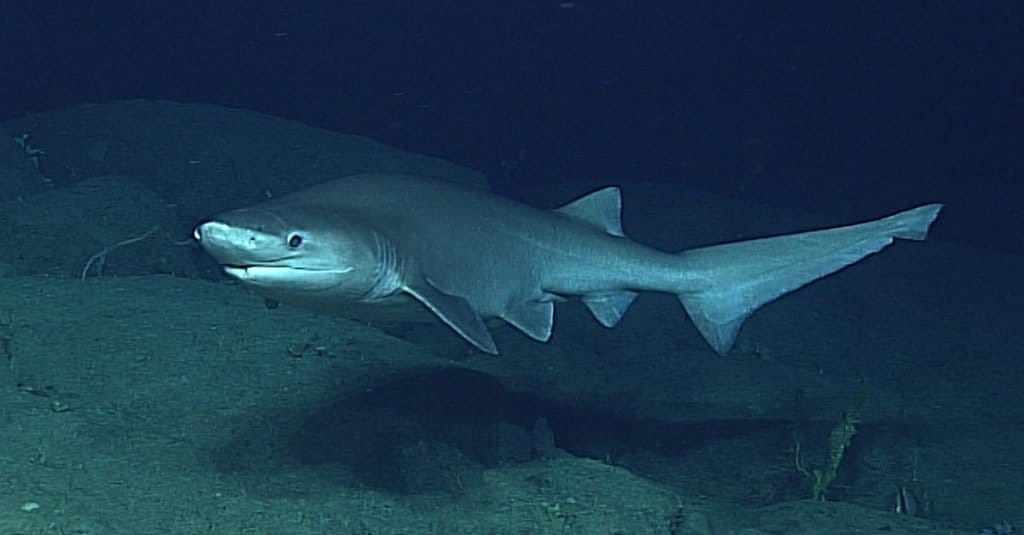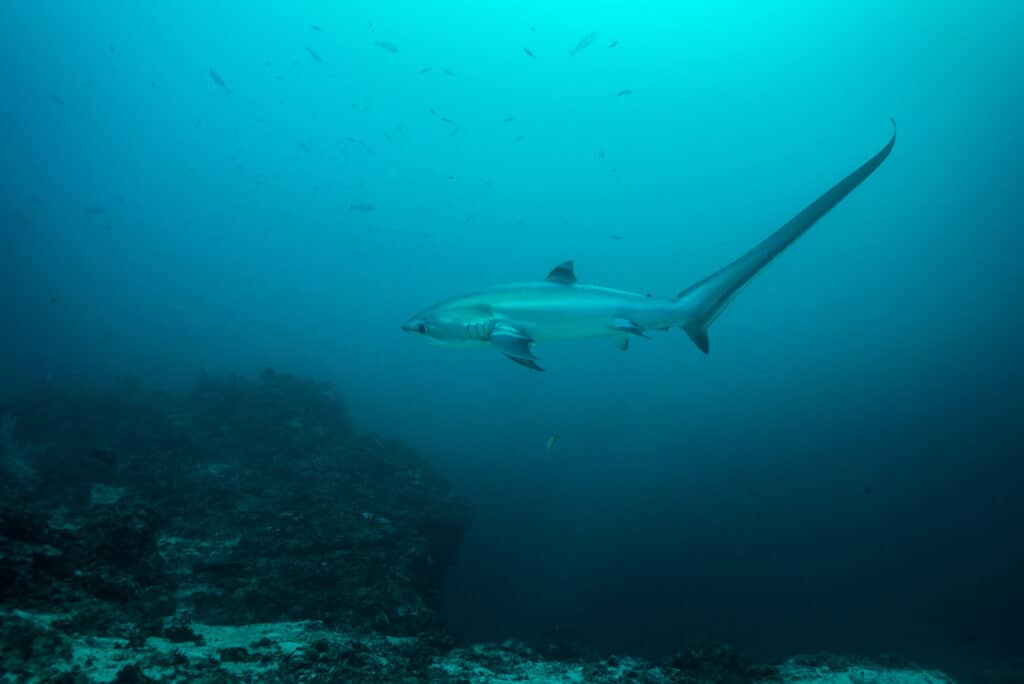A nearly landlocked body of saltwater, the Black Sea is a unique habitat that hosts a range of marine life able to tolerate lower salinity environments. While some Mediterranean shark species don’t thrive in the Black Sea, others travel seasonally through the narrow Bosporus Strait to reach this marginal sea.
In this guide, we’ll discover five species of sharks that live in the Black Sea. Read on to learn more!
1. Sharks That Live in the Black Sea: Spiny Dogfish (Squalus acanthias)
A bottom-dwelling shark of the Squalidae family, the spiny dogfish (Squalus acanthias) is a highly migratory species inhabiting temperate and subarctic waters of the North Atlantic and North Pacific Oceans. The population of spiny dogfish in the Black Sea is most abundant during spring and summer. Indeed, the spiny dogfish is the most commonly occurring shark in the Black Sea.
In these waters, the spiny dogfish prey on small schooling fish such as the Black Sea sprat and invertebrates like shrimp and crab. Typically, this shark also preys on small squid, but the low salinity levels of the Black Sea render the environment inhospitable to squid.
A small species, the spiny dogfish generally reaches a maximum length of 4 feet and weighs about 25 pounds. They grow pretty slowly, with females reaching reproductive maturity at about 35 and males at an average age of 19.

The spiny dogfish is the most abundant shark species in the Black Sea.
©Joern_k/Shutterstock.com
2. Sharks That Live in the Black Sea: Small-Spotted Catshark (Scyliorhinus canicula)
Inhabiting sandy, gravelly, and muddy seafloors down to 1,300 feet, the small-spotted catshark occurs primarily throughout the northeast Atlantic and Mediterranean Sea, with a population occurring occasionally to abundantly in the upper slopes and shelves of the Black Sea. This nocturnal, generalist hunter feeds on various small marine life, such as mollusks, crustaceans, seaworms, and small fish.
The small-spotted catshark reaches a maximum size of about 40 inches and will curl into a tight doughnut shape when threatened to look larger and become harder to prey upon. Unlike the long-lived spiny dogfish, the small-spotted catshark typically only lives about 12-15 years.

The small-spotted catshark feeds on a variety of small marine life in the shallow waters of the Black Sea.
©atese/iStock via Getty Images
3. Bluntnose Sixgill Shark (Hexanchus griseus)
While the bluntnose sixgill shark (Hexanchus griseus) is not a well-known visitor of the Back Sea, recent studies by Turkish scientists have confirmed the presence of at least one individual roaming the western region of the Black Sea. The study also lists 15-20 specimens confirmed in the Sea of Marmara, the body of water directly on the western side of the Bosporus Strait. These sightings strengthen the theory that bluntnose sixgill sharks rarely inhabit the western Black Sea.
These nocturnal predators feed on a range of bony and cartilaginous fishes, including chimeras and rays known to inhabit the Black Sea. This highly migratory species primarily inhabits waters deeper than 300 feet, with a maximum recorded depth of 6,152 feet. The Black Sea has a maximum depth of 7,257 feet. However, because of a lack of strong sea currents and a minimum influx of seawater, the Black Sea is anoxic below 300 feet. As a result, only anaerobic bacteria survive below this boundary. While the sixgill bluntnose shark inhabits the deep sea, this species does rise to shallow waters when hunting at night. As such, the species may inhabit the Black Sea’s oxygen-rich shallow coastal waters at night to hunt.

Researchers have confirmed the presence of at least one bluntnose
sixgill shark
in the western region of the Black Sea.
©NOAA Ocean Explorer from USA / CC BY-SA 2.0 – License
4. Sharks That Live in the Black Sea: Common Thresher Shark (Alopias vulpinus)
The largest member of the thresher family (Alopiidae), the common thresher shark (Alopias vulpinus), is confirmed to inhabit the Black Sea rarely. Primarily inhabiting shallow waters, the common thresher shark uses its whiplike tail to hunt surface-inhabiting marine life of the Black Sea.
The common thresher sharks prey upon fish such as the European anchovy and Black Sea shad in these waters. Like its relatives in the Alopiidae family, this species uses its elongated and powerful tail to stun its prey. The common thresher shark’s tail can reach up to 9 feet long.

In the Black Sea, small numbers of the common thresher shark prey upon fish like
anchovies
, herring, and shad.
©bearacreative/Shutterstock.com
5. Smooth Hammerhead (Sphyrna zygaena)
The smooth hammerhead shark (Sphyrna zygaena) is a rare but confirmed visitor to the Black Sea. These sharks enjoy a circumglobal distribution in tropical and temperate waters. They generally prefer warm temperate waters, migrating to the Black Sea during the summer when the shallow waters reach between 73 and 79 degrees Fahrenheit.
These active predators, including bony fish, rays and skates, crustaceans, cephalopods, sea snakes, and other sharks, feed on prey in coastal waters. In the Black Sea, these sharks may dine on the plentiful populations of anchovies, herring, and shad, as well as rays, skates, and smaller sharks such as the spiny dogfish.

The smooth
hammerhead shark
makes rare appearances in the coastal regions of the Black Sea.
©iStock.com/Michael Zeigler
The photo featured at the top of this post is © Boris Pamikov/Shutterstock.com
Thank you for reading! Have some feedback for us? Contact the AZ Animals editorial team.







